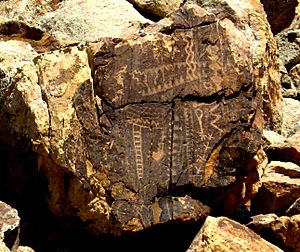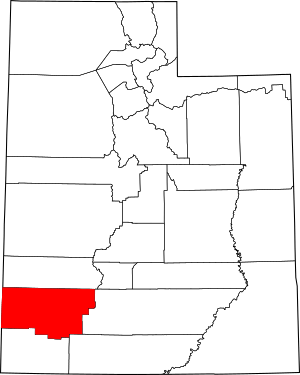Iron County, Utah facts for kids
Quick facts for kids
Iron County
|
|
|---|---|

The Parowan Gap petroglyphs, a well-known landmark in Iron County, July 2007
|
|

Location within the U.S. state of Utah
|
|
 Utah's location within the U.S. |
|
| Country | |
| State | |
| Founded | January 31, 1850 (created) January 17, 1851 (organized) |
| Named for | Iron mines |
| Seat | Parowan |
| Largest city | Cedar City |
| Area | |
| • Total | 3,301 sq mi (8,550 km2) |
| • Land | 3,297 sq mi (8,540 km2) |
| • Water | 4.4 sq mi (11 km2) 0.1% |
| Population
(2020)
|
|
| • Total | 57,289 |
| • Estimate
(2023)
|
64,211 |
| • Density | 17.3550/sq mi (6.7008/km2) |
| Time zone | UTC−7 (Mountain) |
| • Summer (DST) | UTC−6 (MDT) |
| Congressional district | 2nd |
Iron County is a county in southwestern Utah, United States. As of the 2020 United States Census, the population was 57,289. Its county seat is Parowan, and the largest city is Cedar City.
The Cedar City, UT Micropolitan Statistical Area includes all of Iron County.
Contents
History
Evidence of Fremont culture habitation ranging from 750 to 1250 AD exists in present Iron County. Petroglyphs of differing periods were carved into the walls of Parowan Gap NW of Parowan. Paiutes roamed the Parowan Valley in the centuries before Euro-American exploration; their descendants are now represented by the Southern Paiute Indian Reservation, which is headquartered in Cedar City.
The Domínguez–Escalante expedition traveled through the Iron County area on October 12, 1776. Fur trapper Jedediah Smith is the first recorded Anglo-American to pass through the area (1826). Settlement of the area began in 1851, when LDS President Brigham Young directed members from the northern colonies to move into the area. A settlement, Coal Creek, sprang up in 1851; it later became Cedar City. To provide a local government structure, the State of Deseret legislature created the county on January 31, 1850, although it was not organized until January 17, 1851, with description stretching from the future Colorado, across Utah, and into the future Nevada. It was named "Little Salt Lake County" at creation, but on December 3, 1850, a legislative act changed its name to Iron County. Its borders were altered in 1850, 1852, 1854, 1856, and 1861. Also, in 1861, the federal government created the Colorado Territory, which administratively removed Iron County areas east of 109 degrees longitude.
The county borders were altered in 1862. Also, in 1862, the federal government created the Nevada Territory, which administratively removed Iron County areas west of 114 degrees longitude. Further boundary adjustments were passed in 1866, 1880, 1882, 1883, and 1884. The final adjustment was made in 1892; the county borders have remained in their current arrangement.
Geography
Iron County lies on the west edge of Utah. Its west border abuts the east border of the state of Nevada. The Iron County terrain is a study in contrast to its arid western reaches of the Escalante Desert and Great Basin ranges to the meadows and forests of the High Plateau on the east. The Markagunt Plateau is creased by the colorful formations of Cedar Breaks National Monument. Brian Head is the county's highest point, at 11,307 feet (3,446 m) ASL. The county has a total area of 3,301 square miles (8,550 km2), of which 3,297 square miles (8,540 km2) is land and 4.4 square miles (11 km2) (0.1%) is water.
Major highways
- Interstate 15
- Utah State Route 14
- Utah State Route 56
- Utah State Route 130
- Utah State Route 143
- Utah State Route 148
Adjacent counties
- Beaver County - north
- Garfield County - east
- Kane County - southeast
- Washington County - south
- Lincoln County, Nevada - west
Protected areas
- Cedar Breaks National Monument
- Dixie National Forest (part)
- Fishlake National Forest (part)
- Red Cliffs National Conservation Area (part)
- Zion National Park (part)
Lakes
- Little Salt Lake
- Newcastle Reservoir
- Quichapa Lake
Valleys
- Dan Leigh Hollow
Demographics
| Historical population | |||
|---|---|---|---|
| Census | Pop. | %± | |
| 1850 | 360 | — | |
| 1860 | 1,010 | 180.6% | |
| 1870 | 2,277 | 125.4% | |
| 1880 | 4,013 | 76.2% | |
| 1890 | 2,683 | −33.1% | |
| 1900 | 3,546 | 32.2% | |
| 1910 | 3,933 | 10.9% | |
| 1920 | 5,787 | 47.1% | |
| 1930 | 7,227 | 24.9% | |
| 1940 | 8,331 | 15.3% | |
| 1950 | 9,642 | 15.7% | |
| 1960 | 10,795 | 12.0% | |
| 1970 | 12,177 | 12.8% | |
| 1980 | 17,349 | 42.5% | |
| 1990 | 20,789 | 19.8% | |
| 2000 | 33,779 | 62.5% | |
| 2010 | 46,163 | 36.7% | |
| 2020 | 57,289 | 24.1% | |
| 2023 (est.) | 64,211 | 39.1% | |
| US Decennial Census 1790–1960 1900–1990 1990–2000 2010 2020 |
|||
2020 census
According to the 2020 United States census and 2020 American Community Survey, there were 57,289 people in Iron County with a population density of 17.4 people per square mile (6.7/km2). Among non-Hispanic or Latino people, the racial makeup was 47,620 (83.1%) White, 375 (0.7%) African American, 948 (1.7%) Native American, 621 (1.1%) Asian, 237 (0.4%) Pacific Islander, 154 (0.3%) from other races, and 1,852 (3.2%) from two or more races. 5,482 (9.6%) people were Hispanic or Latino.
There were 28,404 (49.58%) males and 28,885 (50.42%) females, and the population distribution by age was 16,259 (28.4%) under the age of 18, 33,214 (58.0%) from 18 to 64, and 7,816 (13.6%) who were at least 65 years old. The median age was 28.9 years.
There were 18,731 households in Iron County with an average size of 3.06 of which 13,596 (72.6%) were families and 5,135 (27.4%) were non-families. Among all families, 10,799 (57.7%) were married couples, 978 (5.2%) were male householders with no spouse, and 1,819 (9.7%) were female householders with no spouse. Among all non-families, 3,592 (19.2%) were a single person living alone and 1,543 (8.2%) were two or more people living together. 6,906 (36.9%) of all households had children under the age of 18. 12,133 (64.8%) of households were owner-occupied while 6,598 (35.2%) were renter-occupied.
The median income for a Iron County household was $52,045 and the median family income was $63,633, with a per-capita income of $22,409. The median income for males that were full-time employees was $45,178 and for females $33,841. 16.4% of the population and 10.2% of families were below the poverty line.
In terms of education attainment, out of the 29,881 people in Iron County 25 years or older, 1,977 (6.6%) had not completed high school, 6,903 (23.1%) had a high school diploma or equivalency, 12,374 (41.4%) had some college or associate degree, 6,205 (20.8%) had a bachelor's degree, and 2,422 (8.1%) had a graduate or professional degree.
Ancestry
The top 5 ethnic groups in Iron County are:
Recreation
- Woods Ranch Recreation Area, a recreation area located in a pine/aspen forest with hiking, fishing, picnic areas, a volleyball court and restroom facilities.
- Three Peaks Recreation Area, a recreation area made up of volcanic rock and hills. The area features rock climbing, picnics, fishing, off-road vehicle use and bike riding.
- Shooting Range
- Brian Head Ski Resort
Communities
Cities
- Cedar City
- Enoch
- Parowan (county seat)
Towns
Census-designated places
- Beryl Junction
- Cedar Highlands
- Modena
- Newcastle
- Summit
Unincorporated communities
- Beryl
- Buckhorn Springs
- Hamiltons Fort
- Hamlin Valley
- Lund
- Old Irontown
- State Line
- Zane
Former communities
- Gold Springs
- Iron Springs, named for the Iron Springs
- Uvada
Education
There is one school district, Iron School District.
See also
 In Spanish: Condado de Iron (Utah) para niños
In Spanish: Condado de Iron (Utah) para niños


